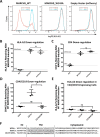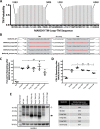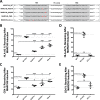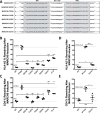A serine in the first transmembrane domain of the human E3 ubiquitin ligase MARCH9 is critical for down-regulation of its protein substrates
- PMID: 30554144
- PMCID: PMC6378983
- DOI: 10.1074/jbc.RA118.004836
A serine in the first transmembrane domain of the human E3 ubiquitin ligase MARCH9 is critical for down-regulation of its protein substrates
Abstract
The
Keywords: E3 ligase; T-cell; immunology; major histocompatibility complex (MHC); membrane protein; membrane-associated RING-CH (MARCH); nuclear magnetic resonance (NMR); receptor endocytosis; transmembrane domain; ubiquitin ligase.
© 2019 Tan et al.
Conflict of interest statement
The authors declare that they have no conflicts of interest with the contents of this article
Figures








Similar articles
-
Structural requirements for recognition of major histocompatibility complex class II by membrane-associated RING-CH (MARCH) protein E3 ligases.J Biol Chem. 2012 Aug 17;287(34):28779-89. doi: 10.1074/jbc.M112.381541. Epub 2012 Jul 3. J Biol Chem. 2012. PMID: 22761441 Free PMC article.
-
Stable isotope labeling by amino acids in cell culture and differential plasma membrane proteome quantitation identify new substrates for the MARCH9 transmembrane E3 ligase.Mol Cell Proteomics. 2009 Aug;8(8):1959-71. doi: 10.1074/mcp.M900174-MCP200. Epub 2009 May 20. Mol Cell Proteomics. 2009. PMID: 19457934 Free PMC article.
-
Membrane-associated RING-CH (MARCH) proteins down-regulate cell surface expression of the interleukin-6 receptor alpha chain (IL6Rα).Biochem J. 2019 Oct 15;476(19):2869-2882. doi: 10.1042/BCJ20190577. Biochem J. 2019. PMID: 31488575
-
A novel family of membrane-bound E3 ubiquitin ligases.J Biochem. 2006 Aug;140(2):147-54. doi: 10.1093/jb/mvj160. J Biochem. 2006. PMID: 16954532 Review.
-
Downregulation of cell surface receptors by the K3 family of viral and cellular ubiquitin E3 ligases.Immunol Rev. 2005 Oct;207:112-25. doi: 10.1111/j.0105-2896.2005.00314.x. Immunol Rev. 2005. PMID: 16181331 Review.
Cited by
-
MARCH5 requires MTCH2 to coordinate proteasomal turnover of the MCL1:NOXA complex.Cell Death Differ. 2020 Aug;27(8):2484-2499. doi: 10.1038/s41418-020-0517-0. Epub 2020 Feb 24. Cell Death Differ. 2020. PMID: 32094511 Free PMC article.
-
MARCH family E3 ubiquitin ligases selectively target and degrade cadherin family proteins.PLoS One. 2024 May 9;19(5):e0290485. doi: 10.1371/journal.pone.0290485. eCollection 2024. PLoS One. 2024. PMID: 38722959 Free PMC article.
-
Role of MARCH E3 ubiquitin ligases in cancer development.Cancer Metastasis Rev. 2024 Dec;43(4):1257-1277. doi: 10.1007/s10555-024-10201-x. Epub 2024 Jul 22. Cancer Metastasis Rev. 2024. PMID: 39037545 Review.
-
Investigating the Prognostic and Oncogenic Roles of Membrane-Associated Ring-CH-Type Finger 9 in Colorectal Cancer.Genet Res (Camb). 2024 Aug 17;2024:9279653. doi: 10.1155/2024/9279653. eCollection 2024. Genet Res (Camb). 2024. PMID: 39185021 Free PMC article.
-
RNF41 regulates the damage recognition receptor Clec9A and antigen cross-presentation in mouse dendritic cells.Elife. 2020 Dec 2;9:e63452. doi: 10.7554/eLife.63452. Elife. 2020. PMID: 33264090 Free PMC article.
References
Publication types
MeSH terms
Substances
LinkOut - more resources
Full Text Sources
Molecular Biology Databases
Research Materials

